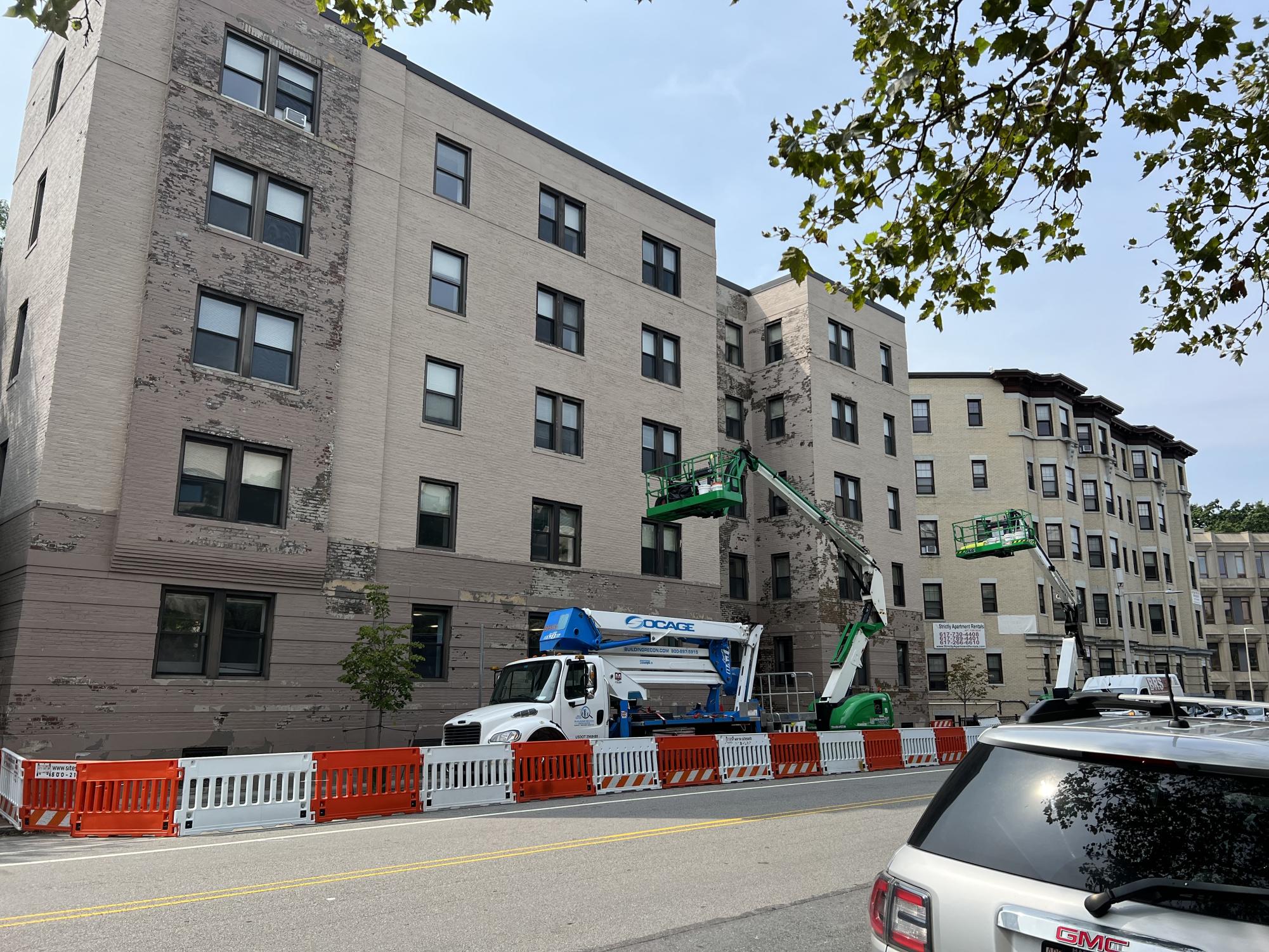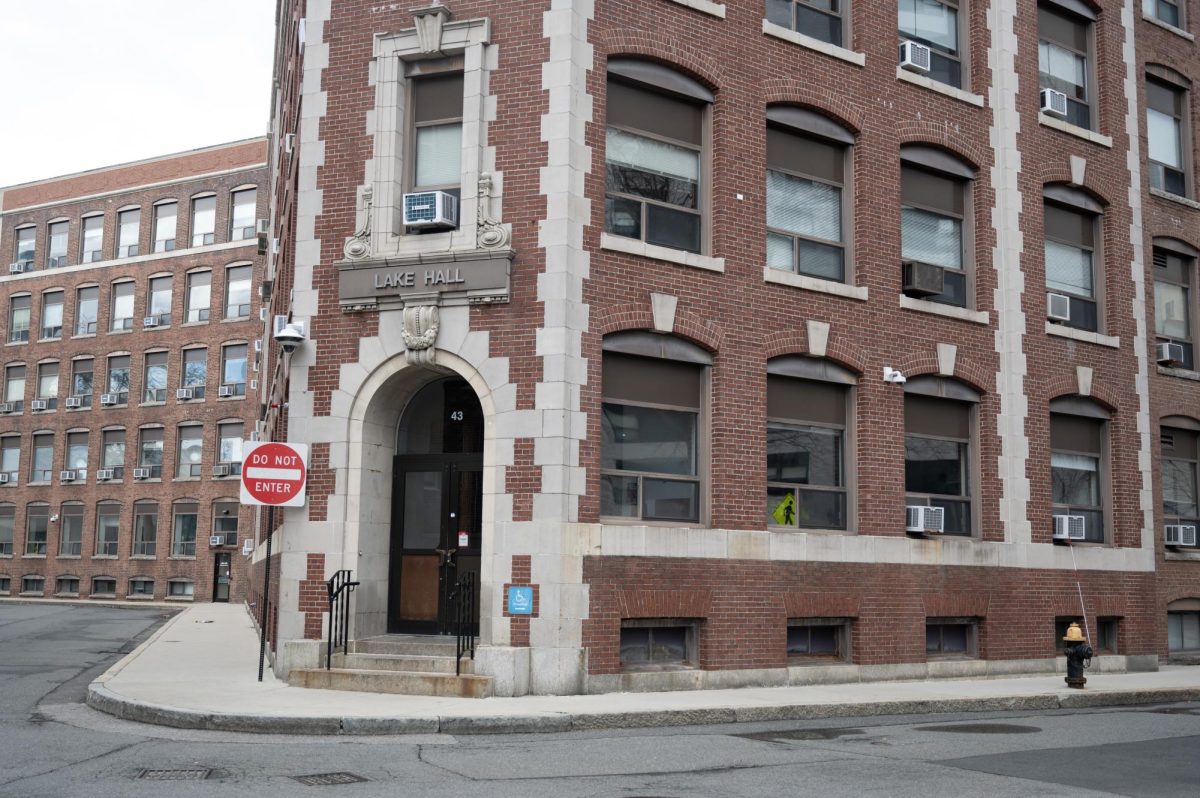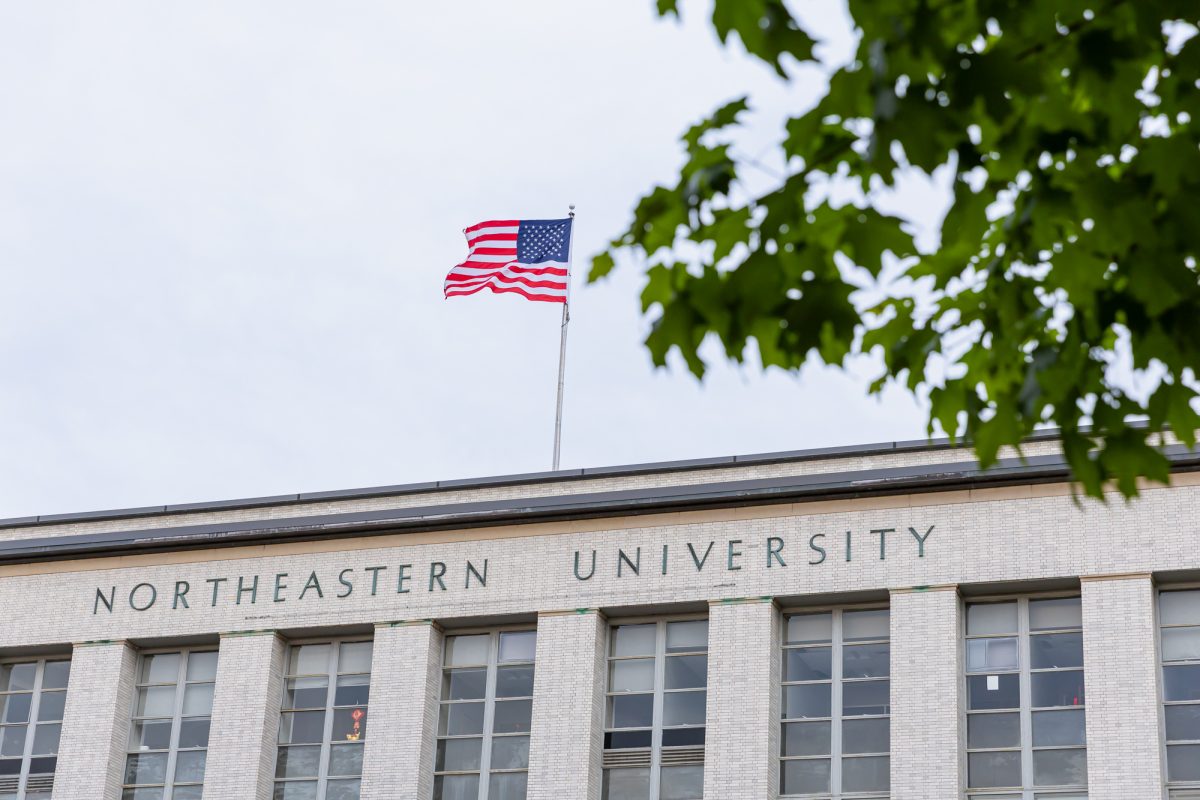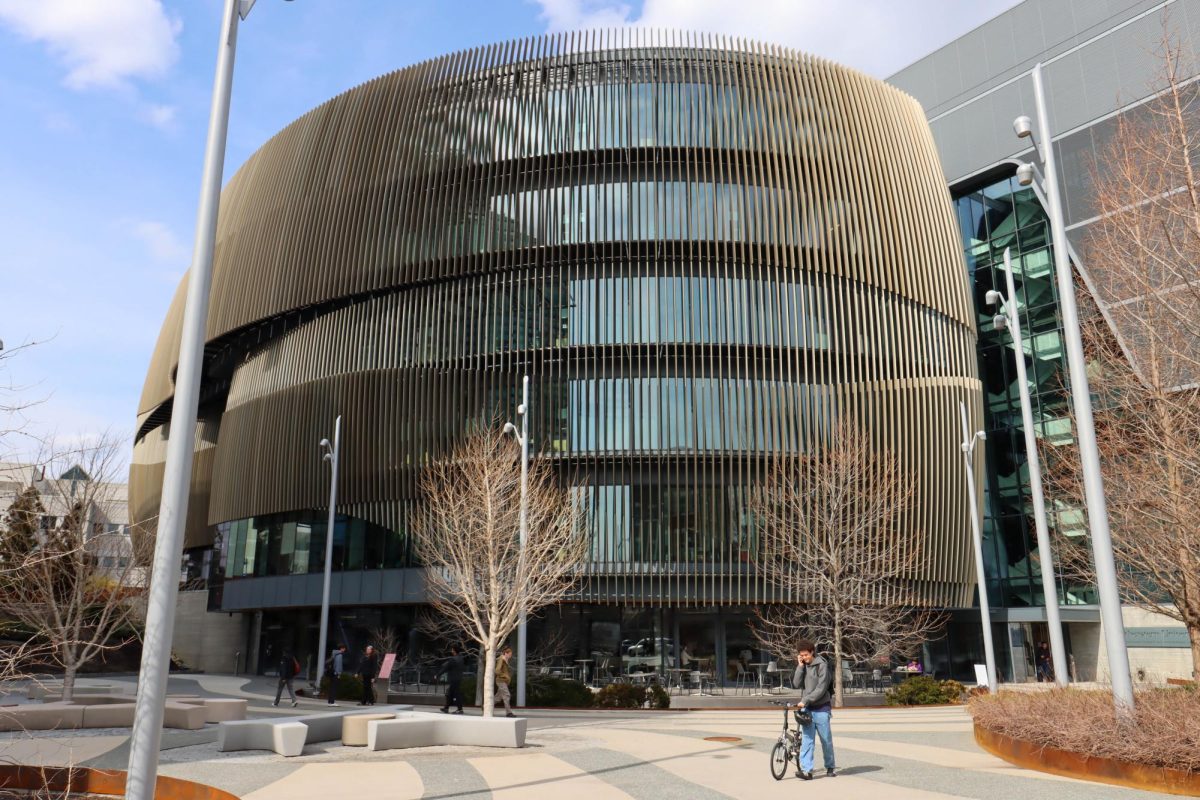At a February faculty senate meeting, Northeastern facilities department representatives said they assume there is asbestos present in certain older buildings on campus until proven otherwise during construction or renovations.
Faculty at the meeting expressed concerns, arguing the school should do more to protect its staff from potential asbestos exposure. Others, however, said they’re confident the school is taking steps to protect them and that, because the presence of asbestos doesn’t pose a threat unless the material is disturbed and becomes airborne, their health is not endangered.
The buildings mentioned at the meeting included those previously known as the United Realty Complex: Lake, Holmes, Meserve and Nightingale halls. The oldest of these buildings, Meserve Hall, was constructed in 1893, Associate Vice President for Facilities Operations Joe Lalley said at the meeting.
Lalley said Northeastern always “presumes that [asbestos] is present until proven otherwise,” and that if a concern is raised during renovation work the university “will engage a third party to come in and do testing of the site.”
“Our strategies that are done by a licensed abatement contractor are remove or encapsulate,” Lalley said, according to the Feb. 28 meeting minutes. “Both of those are very acceptable strategies. We earmark about $800,000 a year for this. If we’ve confirmed asbestos is there, we do our best to see that it goes away in the right way and done by the right people.”
Asbestos, a mineral fiber that naturally occurs in rock and soil composed of thin, needle-like crystals, can cause diseases such as lung cancer, mesothelioma and asbestosis. Its resistance to heat, electricity and corrosion caused it to be widely used in construction materials, particularly as an insulator, throughout the 20th century.
The link between asbestos and cancer was discovered in 1934, however bans against it were not enacted until the early 1980s, when Iceland became the first country to ban all types of asbestos. Today, 55 nations have banned its use.
The United States has made progress towards reducing asbestos use. In 1970, the Clean Air Act classified asbestos as hazardous and allowed the Environmental Protection Agency to regulate it, and a partial ban in 1989 further limited its use. However, the U.S. has yet to enact a full ban, and continues to import and use asbestos today.
Certain faculty members were not satisfied with Lalley’s response, such as Valerio Toledano Laredo, a professor of mathematics, who questioned the facilities office’s reactive — rather than proactive — response.
Toledano Laredo said that as far as he is aware, there has been no inspection of floors four and five of Lake and Nightingale Hall, where the mathematics department is located, during his 18 years at Northeastern. He called for a “thorough inspection of the building[s] floor by floor” in order to certify that all asbestos-containing materials are sealed and do not pose a risk to faculty.
Communications professor Heidi Kevoe-Feldman later echoed this, saying, “If there is a way to do air monitoring in every building, office [and] floor for extra reassurance, faculty would really appreciate that. And [I] would argue that would be an essential expense. If this has already been done, let faculty know.”
Nursing Co-op Coordinator Jacki Diani extended the conversation beyond the United Realty Complex and said for years, there has been concern amongst faculty in Robinson Hall about asbestos. Since there are renovations planned in the building for this summer, she asked for assurance that an asbestos evaluation will take place alongside the renovation work.
Lalley said there has been “a lot of work going on in Robinson” to replace two pipe systems that previously failed and caused flooding.
“We are touching every space in that building and probably testing every space, and the outcome of that should be a good assessment of what remains in that building,” he said. “We know that there is asbestos in Robinson. We have known about it for years.”
Lalley said superintendents, facilities and maintenance staff are in the buildings daily and are trained to look for signs of asbestos and report them, ensuring a safe work environment for staff as per requirements from the Occupational Safety and Health Administration, or OSHA.
Lalley did not elaborate on what these “signs” might be, and asbestos fibers are odorless and not visible to the naked eye. Some asbestos-containing products show dimpling over time, which is a possible tell, but the only way to ensure a material contains asbestos is through laboratory testing.
In a statement provided to The News, a Northeastern spokesperson said that buildings built before the 90s are likely to contain asbestos, but did not elaborate on what signs staff are trained to look for.
“Aging buildings are common across the city and beyond, including several on Northeastern’s Boston campus,” the statement read. “Asbestos-containing materials are not considered hazardous as long as they are properly encapsulated. Abatement and encapsulation are approved and commonly used maintenance techniques.”
Alan Waters, a health and safety officer at Online Facilities Management Limited who has worked with asbestos for 15 years, confirmed asbestos does not pose a risk unless the material is damaged.
“If you leave [asbestos] in place and you don’t damage it, it won’t cause any problems,” Waters said, although he expects that Northeastern would need to have had an asbestos management survey done to confirm or deny the presence of asbestos in buildings.
This differs from air testing, which, Waters said, is “not usually done unless you’re doing construction work.” Instead, this survey involves a professional taking “very small samples, analyzing them, reporting if [they] found asbestos, where [they] found it and what [their] recommendations are.”
“If [asbestos] is [found] in a good condition, the recommendation is to leave it in place and have it checked every year,” Waters said, adding that annual checking would incur additional costs.
“If they find asbestos and it’s crumbling and falling apart they’ll say ‘have it removed,’ and then you’re into a whole different ball game,” Waters said. “You’ll need specialists to take it out under controlled conditions.”
This is a much more costly process, at $1,000 to $4,000 per 200 square feet. Overall, Waters said that the presence and threat of asbestos is dependent on the specificities of the building.
“It’s all about the type of asbestos and how risky it is, in other words, how likely it is to be damaged,” Waters said.
The Massachusetts state government also advises that if asbestos-containing material is in good condition, the best thing to do is to leave it alone. This aligns with Northeastern’s stance that unless the material is going to be disturbed as a result of construction, measures to remove it do not need to be taken.
However, OSHA requires all colleges to survey their buildings and test for asbestos.
“Northeastern complies with all local, state, and federal requirements for proper maintenance of buildings that may contain asbestos,” the university said in its statement to The News. “The university regularly inspects these buildings with licensed and trained facilities staff, and initiates abatement work as needed.”
Daniel Douglass, a marine and environmental science professor who’s had a basement office in Holmes Hall since 2007, was unaware of the conversation about asbestos at the senate meeting, but is not concerned about the presence of asbestos in the building that houses his office, he said.
“I’m not worried … if they know there’s asbestos in an exposed location and they’re not cleaning it up I’d be super mad, but if you’re not breathing it, it doesn’t matter,” Douglass said.
He said he’s more concerned about other issues that come from working in an older building.
“We’re in the basement, so we spend much more time thinking about when it rains really hard and water sometimes floods into the basement,” Douglass said. “We joke like ‘Oh it’s been a whole year since it flooded the last time.’’’
He added he is confident that if asbestos was discovered, Northeastern would “take the right steps and do something about it.”
Another professor, who requested anonymity due to fear of retaliation, said they believe the school may be holding back from getting a full assessment done.
When asked if faculty would protest the university’s refusal to test buildings, the professor said they were unsure.
“It’s a scary-sounding kind of thing, but sometimes you have to ask the degree to which it is really an issue,” they said. “There can be a reluctance for staff to speak out about this kind of stuff.”
The professor suggested that a student protest might be less risky and more effective.
“I think the university listens to students more than faculty … particularly if parents get involved,” they said. “They’re not gonna kick [students] out of school for it right? But for [faculty] there is that concern about your job security.”
The professor also commented on Toledano Laredo’s comparison between the cost of asbestos testing and the construction of EXP.
“I understand I’m talking about a lot of money, but EXP costs $400 million and we’re talking about people’s lives and health here,” Toledano Laredo said at the meeting. “This can cause lung cancer. This isn’t a trivial matter.”
Northeastern’s most recent construction projects, EXP and ISEC, are both dedicated to STEM research, while the humanities classes continue to be taught in older buildings, like the United Realty Complex.
“STEM programs and departments bring in a lot of money into the university, and I’m sure that’s a lot of their justification for building these giant multimillion-dollar new projects,” the professor said. “Whether it’s Northeastern or other places, you’re not seeing a lot of these, multimillion-dollar facilities for humanities and arts. So it’s not surprising that we’re in the older buildings.”














